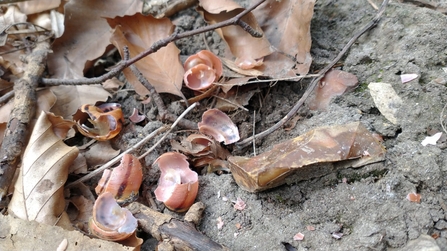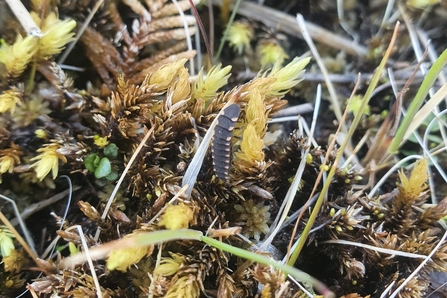Weekly wild news from our reserves - 30 April
Arger Fen - Steve Aylward
Song thrushes will eat all kinds of food, with earthworms making up a large part of their diet. When the ground becomes too hard to get at the worms, they will eat snails instead. When song thrushes are unable to break into snail shells, they look for a suitable stone then they take the shell and crack it open by banging it against the stone 'anvil'. This ingenious behaviour is unique to these birds. Warden Dan Doughty found evidence of just this at Reydon Wood recently.

Song thrush anvil and smashed snail shells at Reydon Wood – Dan Doughty
Nightingale and chiffchaff singing
Listen to the beautiful melody of the nightingale along with chiffchaff calling at Bromeswell Green nature reserve recently.
A tale of two woods
As we move from late April into May, our ancient woodlands start to reveal their secrets. Leaf-littered floors are now green with lush flowering species, many of which are starting to reveal their fruiting bodies, like this early purple orchid at Bradfield woods and wood spurge, wood sorrel and greater stitchwort at Arger Fen. Carpets of bluebells will soon be lighting up our senses as they reach a crescendo of colour and scent in the coming few weeks and what look like lifeless stumps, like this hawthorn pollard depicted here at Bradfield, start to sprout the shoots of new growth and new life. Bradfield Woods and Arger Fen are well worth a visit whatever time of the year but if you would like a reminder of what it feels like to be connected to nature, a gentle amble through one of these very special places will go a very long way.
Blue-in-the-face blue tit
Sometimes it can take a lot of unbridled energy when you’re up against someone just like you! This blue tit is displaying territorial behaviour when confronted by its own reflection; it thinks that another bird is intruding and is trying to drive it away by pecking at it. Maybe time to reflect in a different way!?
A bright light for any dark nights ahead
How Warden Joe Bell-Tye spotted this glow worm larvae we’ll never know – what excellent camouflage! Joe explained that ‘the larvae of glow-worms are predators, feeding on slugs and snails. They kill their prey by delivering a series of toxic bites, injecting digestive proteins that paralyse and eventually dissolve the soft body of the slug or snail. While the glow-worm is waiting for this process to happen, it might ride on the snail's back, keeping away from the sticky mucus it produces!’
The glow-worm itself is a medium-sized, narrow beetle. The males look like typical beetles, but the females have no wings and look similar to the larvae. Gardens, hedgerows, railway embankments, woodland rides, heathlands and cliffs are all possible habitats for glow-worms. Females are famous for emitting a greeny-orange light from their bottoms at night. They climb up plant stems and glow in order to attract males, who have large, photosensitive eyes - perfect for scanning vegetation in the dark. The larvae can also emit light, and so can the eggs. The male glow-worm is a light brown, typical beetle. The larva is greyish-brown with yellowy-orange triangular markings at the side of each segment. The female is similar in appearance to the larva, but is unmistakeable when she lights up at night.

Glow worm larvae at Redgrave & Lopham Fen – Joe Bell-Tye







